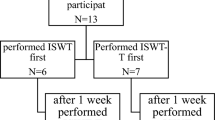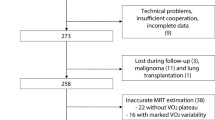Abstract
Background
Low cardiopulmonary fitness, measured by oxygen uptake peak (VO2pk), is associated with postoperative complications and mortality. Obese people have difficulty in performing the cardiopulmonary exercise test, which requires maximal exertion. The incremental shuttle walking test (ISWT) and 6-min walking test (6MWT) have been used to assess cardiorespiratory capacity, mortality, and complications in the postoperative phase. However, the physiological response elicited by these tests in obese people is unknown. This study analyzed and compared cardiopulmonary fitness (oxygen uptake [VO2] and CO2 output [VCO2]) in the ISWT and 6MWT in obese adults using a telemetry system.
Methods
Fifteen obese patients (10 women; mean age 39.4 ± 10.1 years; mean body mass index 43.5 ± 6.8 kg/m2) with normal forced vital capacity (% FVC 93.7) performed the 6MWT and ISWT in the field in this cross-sectional study. Metabolic (VO2pk, VCO2) and respiratory (minute ventilation; VE) variables were recorded using telemetry.
Results
Obese patients performed the ISWT with an incremental and exponential cardiopulmonary response, with higher VO2pk (15.4 ± 2.9 ml/kg/min), VCO2 (1.7 ± 0.7 l/min), and VE (51.4 ± 21.3 l/min) than the 6MWT (VO2pk = 13.2 ± 2.59 ml/kg/min, VCO2 = 1.4 ± 0.6 l/min; VE = 41.2 ± 16.6 l/min (all p < 0.01). They also demonstrated more effort intensity, assessed by VO2, (p = 0.006) and heart rate (p = 0.04) in the ISWT than the 6MWT. In the 6MWT, patients showed a fast rise in ventilatory and metabolic response, reaching a plateau.
Conclusion
The ISWT test generated superior metabolic and ventilatory stress than the 6MWT and may be more suitable for assessing cardiopulmonary fitness than self-paced tests.



Similar content being viewed by others
References
Whitlock G, Lewington S, Sherliker P, et al. Body-mass index and cause-specific mortality in 900.000 adults: collaborative analyses of 57 prospective studies. Lancet. 2009;373:1083–6.
Schutter A, Lavie CJ, Milani RV. The impact of obesity on risk factors and prevalence and prognosis of coronary heart disease-the obesity paradox. Prog Cardiovasc Dis. 2014;56:401–8.
Gallagher MJ, Franklin BA, Ehrman JK, et al. Comparative impact of morbid obesity vs heart failure on cardiorespiratory fitness. Chest. 2005;127:2197–3.
Barry VW, Baruth M, Beets MW, et al. Fitness vs. fatness on all-cause mortality: a meta-analysis. Prog Cardiovasc Dis. 2014;56:382.
Kodama S, Saito K, Tanaka S, et al. Cardiorespiratory fitness as a quantitative predictor of all-cause mortality and cardiovascular events in healthy men and women. JAMA. 2009;301:2024–5.
ATS/ACCP—American Thoracic Society/American College of Chest Physicians. Statement on cardiopulmonary exercise testing. Am J Respir Crit Care Med. 2003;167:211–7.
King WC, Engel SG, Elder KA, et al. Walking capacity of bariatric surgery candidates. Surg Obes Relat Dis. 2012;8:48–9.
Poirier P, Cornier MA, Mazzone T, et al. Bariatric surgery and cardiovascular risk factors: a scientific statement from the American Heart Association. Circulation. 2011;123:1683–1.
Wilms B, Ernst B, Thurnheer M, et al. Differential changes in exercise performance after massive weight loss induced by bariatric surgery. Obes Surg. 2013;23:365–1.
McCullough PA, Gallagher MJ, Jong AT, et al. Cardiorespiratory fitness and short-term complications after bariatric surgery. Chest. 2006;130:517–5.
Pulz C, Diniz RV, Alves ANF, et al. Incremental shuttle and six-minute walking tests in the assessment of functional capacity in chronic heart failure. Can J Cardiol. 2008;24:131–5.
Guazzi M, Dickstein K, Vicenzi M, et al. Six-minute walk test and cardiopulmonary exercise testing in patients with chronic heart failure: a comparative analysis on clinical and prognostics insights. Circ Heart Fail. 2009;2:549–5.
ATS statement: guideline for the six-minute walk test. Am J Respir Crit Care Med. 2002;166:111-7.
Dourado VZ, Vidotto MC, Guerra RL. Reference equations for the performance of healthy adults on field walking tests. J Bras Pneumol. 2011;37:607–4.
Singh SJ, Morgan MDL, Scott S, et al. Development of a shuttle walking test of disability in patients with chronic airways obstruction. Thorax. 1992;47:1019–4.
Benzo RP, Sciurba FC. Oxygen consumption, shuttle walking test and the evaluation of lung resection. Respiration. 2010;80:19–3.
Woolf-may K, Meadows S. Exploring adaptations to the modified shuttle walking test. BMJ Open. 2013;2:e002821.
Klijn PHC, Baan-slootweg OH, Stel HF. Aerobic exercise in adolescents with obesity: preliminary evaluation of a modular training program and the modified shuttle test. BMC Pediatr. 2007;19:7–9.
Castro-piñero J, Padilla-moledo C, Ortega FB, et al. Cardiorespiratory fitness and fatness are associated with health complaints and health risk behaviors in youth. J Phys Act Health. 2012;9:642–9.
Dourado VZ, Guerra RL, Tanni SE, et al. Reference values for the incremental shuttle walk test in healthy subjects: from the walk distance to physiological responses. J Bras Pneumol. 2013;39:190–7.
Luxton N, Alison JA, Judy WU, et al. Relationship between field walking tests and incremental cycle ergometry in COPD. Respirology. 2008;13:856–2.
Onorati P, Antonucci R, Valli G, et al. Non-invasive evaluation of gas exchange during a shuttle walking test vs. a 6-min walking test to assess exercise tolerance in COPD patients. Eur J Appl Physiol. 2003;89:331–6.
Vagaggini B, Taccola M, Severino S, et al. Shuttle walking test and 6-minute walking test induce a similar cardiorespiratory performance in patients recovering from an acute exacerbation of chronic obstructive pulmonary disease. Respiration. 2003;70:579–4.
Bergman RN, Stefanovski D, Buchanan DA, et al. A better index of body adiposity. Obesity. 2011;19:1083–9.
Klein S, Allison DB, Heymsfield SB, et al. Waist circumference and cardiometabolic risk: a consensus statement from Shaping America's Health: Association for Weight Management and Obesity Prevention; NAASO, The Obesity Society; the American Society for Nutrition; and the American Diabetes Association. Obesity. 2007;15(5):1061–7.
Neder JA, Nery LE, Peres C, et al. Reference values for dynamic responses to incremental cycle ergometry in males and females aged 20 to 80. Am J Respir Crit Care Med. 2001;164:481–6.
Borg GA. Psychophysical bases of perceived exertion. Med Sci Sports Exerc. 1982;14:377–1.
Dourado VZ, Banov MC, Marino MC, et al. A simple approach to assess VT during a field walk test. Int J Sports Med. 2010;31:698–3.
Bautista J, Ehsan M, Normandin E, et al. Physiologic responses during the six minute walk test in obese and non-obese COPD patients. Respir Med. 2011;05:1189–4.
Blanco I, Villaquirán C, Vallera JL, et al. Peak oxygen uptake during the six-minute walk test in diffuse interstitial lung disease and pulmonary hypertension. Arch Bronconeumol. 2010;46:122–8.
Li J, Li S, Feuers RJ, et al. Influence of body fat distribution on oxygen uptake and pulmonary performance in morbidly obese females during exercise. Respirology. 2001;6:9–13.
Evans RA, Dolmage TE, Robles PG, et al. Do field walking tests produce similar cardiopulmonary demands to an incremental treadmill test in obese individuals with treated obstructive sleep apnea? Chest. 2014;146:81–7.
Jürgensen SP, Trimer R, Dourado VZ, et al. Shuttle walking test in obese women: test-retest reliability and concurrent validity with peak oxygen uptake. Clin Physiol Funct Imaging. 2014;3:1–7.
Acknowledgments
This study was supported by the Conselho Nacional de Desenvolvimento Científico e Tecnológico (National Counsel of Technological and Scientific Development; Research and Projects Financing-45309/2012) from the Ministry of Science, Technology and Innovation, Brazil.
Conflict of Interest
All the authors declared no conflict of interest.
Statement of Informed Consent
Informed consent was obtained from all individual participants included in the study. Additional informed consent does not apply.
Statement of Human and Animal Rights
All procedures performed in studies involving human participants were in accordance with the ethical standards of the institutional and/or national research committee and with the 1964 Helsinki declaration and its later amendments or comparable ethical standards.
Author information
Authors and Affiliations
Corresponding author
Rights and permissions
About this article
Cite this article
Oliver, N., Onofre, T., Carlos, R. et al. Ventilatory and Metabolic Response in the Incremental Shuttle and 6-Min Walking Tests Measured by Telemetry in Obese Patients Prior to Bariatric Surgery. OBES SURG 25, 1658–1665 (2015). https://doi.org/10.1007/s11695-014-1548-8
Published:
Issue Date:
DOI: https://doi.org/10.1007/s11695-014-1548-8




